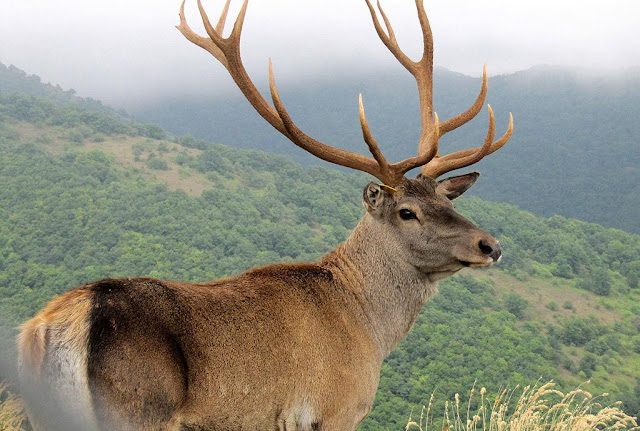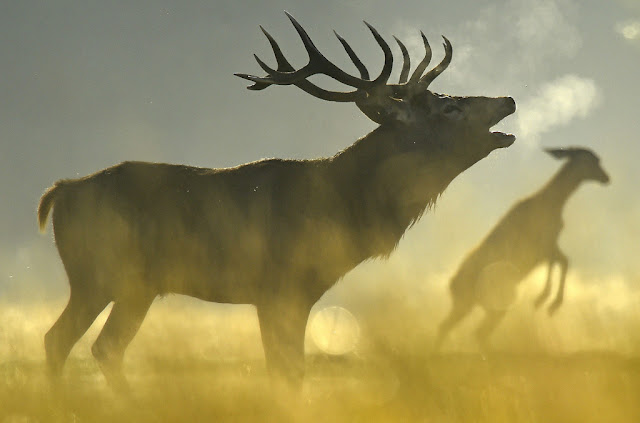FALLOW DEER
The fallow deer (Dama dama) is a ruminant mammal belonging to the family Cervidae. This common species is native to Europe, but has been introduced to Antigua & Barbuda, Argentina, South Africa, Fernando Pó, São Tomé, Madagascar, Mauritius, Mayotte, Réunion, Seychelles, Comoro Islands, Morocco, Algeria, Tunisia, Cyprus, Israel, Cape Verde, Lebanon, Australia, New Zealand, Canada, the United States, the Falkland Islands, and Peru.Some taxonomers include the rarer Persian fallow deer as a subspecies,while others treat it as an entirely different species.
Size:
Adults 1.3 to 1.7 m (4 – 5.5 ft) long; buck (male) stands 85 to 110 cm (nearly 3 to 3.5 ft) at shoulder. Weight 35 to 130 kg (77 – 287 lbs). Females (does) slightly smaller than bucks.
Colour:
Red-brown coat with white spots in summer and grey-brown coat in winter, with less distinct spots. White rumps with black borders; large palmate antlers on males. Four recognised colour phases: Common, Menil (Tan with brown dorsal line), Black and White.
Distribution:
Common throughout UK (naturalised, not native) and much of Central Europe; absent from Iceland and most of Scandinavia. Introduced to America and New Zealand. Bulk of British population in England and Wales; patchy distribution in northern England and Scotland. Population estimated to be growing at ca. 2% per year; current numbers put at 150,000 to 250,000.
Longevity:
In wild reach 8 to 10 yrs, exceptional ages of 16yrs known; oldest captive specimen was 20 yrs old.
Sexing:
Sexing:
Males have antlers for much of year,laryngeal prominence (Adam’s apple) and penile sheath.
Habitat:
Areas of mixed or deciduous woodland and grassy open spaces with shrubby undergrowth for shelter and feeding. Can be found in open conifer stands.
Behaviour and Sociality:
Generally speaking a gregarious species that live in groups of, at times, a hundred individuals. Social structure in does, with single dominant female, although social structure highly variable with environment. Mixed sex groups may form at good feeding sites.
RED DEER
The red deer is one of the largest deer species. The red deer inhabits most of Europe, the Caucasus Mountains region, Asia Minor, Iran, parts of western Asia, and central Asia.
Size:
Adults usually between 1.7 and 2.6 m (5.5 to 8.5 ft) long; full-grown stag stands about 1.2 m (4ft) at the shoulder, while hinds are slightly smaller, at 1 m. Weight 90 to 260 kg (200 – 570 lbs) – seasonally variable.
Colour:
Red-brown summer coat; grey-brown winter coat. Rump patch yellowish colour; stags (males) develop mane during winter. Stags have large antlers that are shed and re-grown each year.
Distribution:
Distribution:
Found throughout Europe; introduced to parts of America, New Zealand and Australia. In UK (native), most common in the Scottish Highlands, although they do exist in isolated pockets across the island. Population estimated at 350,000+; growing at ca. 0.3% per year.
Longevity:
Max. age limit considered to be ~25 years; records of wild individuals living beyond 13 to 15 years are rare.
Sexing:
During much of year males can be identified by presence (or development) of antlers. Females tend to be of slighter build than males.
Behaviour and Sociality:
Hinds live in groups for most of the year (leaving only to have young). Hierarchical system present; single dominant hind with her yearlings and mature daughters from previous matings (possibly with own offspring). Males spend most of the year either solitarily or in small 'unstable' bachelor groups and feed voraciously during spring and summer. Males become antisocial during breeding season, engaging in roaring contests and parallel walking; disputes involve rearing on hind legs and kicking with front feet (when antlers developing) and locking of antlers (once antlers mature). Males and females known to use mud wallows.
The European roe deer,also known as the western roe deer, chevreuil, or simply roe deer or roe, is a Eurasian species of deer. The male of the species is sometimes referred to as a roebuck. The roe deer is relatively small, reddish and grey-brown, and well-adapted to cold environments. The species is widespread in Europe, from the Mediterranean to Scandinavia, from Britain to the Caucasus, and east to northern Iran and Iraq. It is distinct from the somewhat larger Siberian roe deer.
Size:
Adults between 95cm and 1.3 m (3 – 4 ft) long; males (bucks) stand 64 to 67 cm (2 ft) at shoulder. Weight between 15 to 35 kg (33 – 77 lbs).
Colour:
Red-brown coat in summer, grey-brown in winter; white rump; tail virtually absent.
Distribution:
Common throughout UK and Europe except Iceland, northern Scandinavia and Mediterranean Islands; range extends east to Asia. Apparently absent from areas of the midlands and Wales. Population increase estimated at ca. 2.3% per year; current population around 800,000+.
Longevity:
Ave. in wild 5 to 7 years, with max. wild of about 12 yrs. Max. age of 20 yrs (in captivity).
Sexing:
Males have antlers, which grow to max. ~30cm with 3 tines per antler typical; antlers grown in winter and shed during autumn. Sexed by shape of rump patch; females have tail-like mass of hair at the base of tuft, bucks don’t.
Habitat:
Spend much of time in shelter of woodland or upland areas; will move to long grass and shrubby undergrowth for browsing; make more use of open spaces at night. Found in farmland.
Behaviour and Sociality:
Generally solitary; may form groups during winter; does frequently accompanied by kids and home ranges may overlap with other females. Any sociality seems scent-mediated. Bucks may fray trees and shrubs with antler and face glands during the rut. Bark, especially at dawn and dusk, when disturbed - not descriptive of sex, although males tend to bark more than females.
Read more at: wildlifeonline.me.uk
SIKA DEER
The sika deer also known as the spotted deer or the Japanese deer, is a species of deer native to much of East Asia, and introduced to various other parts of the world.Previously found from northern Vietnam in the south to the Russian Far East in the north,it is now uncommon in these areas, excluding Japan, where the species is overabundant.
Size:
Adults 1.14 m to 1.7 m (5.5 ft) long; stag (male) stands 80 to 90 cm (3 ft) at shoulder. Adult males average 64 kg (140 lbs.), females 41 kg (90 lbs.), and newborn calf weighs ca. 3 kg (7 lbs.). Females (hinds) slightly smaller than stags. Size highly variable in accordance with habitat quality.
Colour:
Two moults per year leading to red-brown coat with white spots (all ages) in summer and grey-brown or black coat (with less distinct or absent spots) in winter. White rumps with black stripe down tail and brown border; white metatarsal glands on hock. Antlers similar to Red deer, although smoother texture and max. 4 tines per antler – single front-pointing tine on each antler.
Distribution:
Introduced from Japan some time ca. 1860. Now scattered populations across UK, including England, Scotland and Ireland – largest populations in Scottish Highlands. Absent from much of England and Wales. Population estimated at ca. 35,000; thought to be increasing at ca. 5.3% per year. Outside of UK, scattered populations in Europe (e.g. German, France and Czech Republic) – native range is Japan and South-east Asia.
Longevity:
In wild reach 8 to 10 yrs, exceptional ages of 15 yrs known.
Sexing:
Males have antlers for much of year (shed in spring), laryngeal prominence (Adam’s apple) and penis sheath.
Habitat:
Areas of mixed or deciduous woodland and grassy open spaces with shrubby undergrowth for shelter and feeding. Can be found in open conifer stands and parks.
Behaviour and Sociality:
During late spring and summer (i.e. outside of rutting season), hinds may live in small social groups with calves, although in some areas (e.g. New Forest) majority seen either solitarily or with single calf; stags live either solitarily or in small bachelor groups. Mixed sex groups of adults established during rut and can persist until hinds leave to calve in spring.









































No comments:
Post a Comment